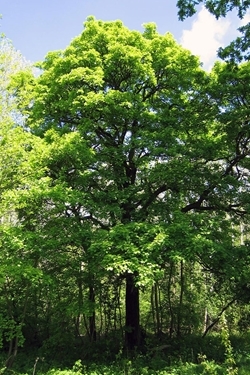Wild service tree
 The wild service tree (Sorbus torminalis) is a deciduous broadleaf tree native to the UK and parts of Europe, Africa and Asia. They are relatively rare now in present day Britain, surviving mainly in oak and ash woods situated on clay- and lime-based soils, where they are believed to be a good indicator that the woodland where they exist is of ancient origin. They can be recognised by their jagged, maple-like leaves, which turn a rich, coppery red in autumn.
The wild service tree (Sorbus torminalis) is a deciduous broadleaf tree native to the UK and parts of Europe, Africa and Asia. They are relatively rare now in present day Britain, surviving mainly in oak and ash woods situated on clay- and lime-based soils, where they are believed to be a good indicator that the woodland where they exist is of ancient origin. They can be recognised by their jagged, maple-like leaves, which turn a rich, coppery red in autumn.
The wild service tree is hermaphrodite, meaning that both male and female reproductive parts are contained within each of the small white flowers, which appear in groups during late spring and are pollinated by insects.
The small, oval unripe fruits are green at first, but slowly turn a reddish brown as they ripen or “blet” – go a little rotten – in the autumn months. At this stage they used to be collected and sold in markets around the country to eat, tasting a bit like dates. They were firm favourites with children, who were given them as a treat, much like we would hand out sweets nowadays.
These little fruits are often called “chequers” and were also used to flavour alcoholic drinks such as beer and whisky, before the hop became the preferred choice. Many believe that this is the reason why many an inn is called the “Chequers” and may even be the reason behind the name of the Prime Minister’s official country residence.
The bark is patterned with cracked square plates, which become flaky and brown with age, giving it a chequerboard appearance, which might also be another reason for the chequers name.
The wood has a lovely fine grain and silvery luminescence to it. It is a hard, heavy timber and often takes on a pale pinkish hue, which distinguishes it from pear wood, which it otherwise resembles. At one time the timber was highly valued, both here and on the continent, for turnery, furniture and cabinet-making. The wood was also particularly sought after for making pistol, gun and crossbow stocks.
Integral to the plucking action of the harpsichord is the jack. There must be at least one jack for each note — larger harpsichords with several choirs of strings will have more. Traditional the jack was always made of a slip of wood, most often sourced from the service or pear tree.
So keep an eye open when walking in woodland or alongside a mature hedgerow, as you might just come across this interesting tree, which rather feels as though it belongs more to a bygone age than it does in present day Britain.
Photo credit: Andrew Dunn [CC BY-SA 2.0, via Wikimedia Commons]

Download Peter Thompson's essential 26-page book, featuring beautiful photography and detailed profiles of Britain's wildlife
Download FREE >